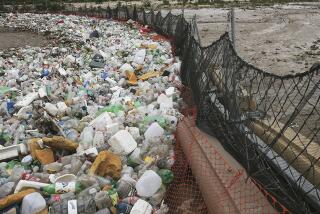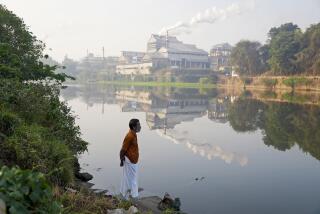Foul Shanghai Sewage System Redesigned in Pasadena
- Share via
The Suzhou Creek, which flows through the center of Shanghai, is so polluted the water looks black. It smells none too pleasant, either.
Half a world away from this creek that is virtually an open sewer, Chinese engineers have been working with American engineers in Pasadena to solve the problem.
At Engineering-Science, a subsidiary of Parsons Corp., one of the world’s largest engineering firms, six engineers from Shanghai have made one corner of a fourth-floor office their home since May.
Surrounded by drafting tables, computers and blueprints, the engineers drew up plans for a $450-million sewage treatment plant for the port city on China’s east coast.
The six engineers--three men and three women--received help from Parsons in designing two huge pipes to channel treated sewage into the estuary of the Yangtze River.
Key to the System
In most cases sewage is simply dumped directly into rivers and creeks such as the Suzhou, which empties into the Huangpu River, a major navigational waterway jammed with everything from freighters to junks.
The two pipes will be integral to the proper functioning of the system. The engineers must resolve complicated issues such as the correct angle of the pipes and the temperature of the sewage.
“Being in Pasadena, we could concentrate on this,” Gu You-Zhi, a Chinese water quality engineer, said in English. “If I was in Shanghai, I would have a lot of other things to do and on my mind.”
The project is part of a plan to make life more manageable in the largest city (13 million) in the world’s most populous nation. Another Parsons subsidiary has been working on improving traffic flow in Shanghai, notorious for gridlock with its 4 million bicycles.
Besides Engineering-Science, firms from Denmark, Australia and Japan are involved in the sewerage project, which is being financed partly by the World Bank. That foreigners are helping seems appropriate.
Tie Systems Together
Part of the difficulty stems from the three separate sewer systems developed by foreign businesses in the late 1800s in what became an international port. One goal of the project is to unify, upgrade and expand the systems, which serve only a small portion of Shanghai’s residents and industries. The new sewage treatment plant, covering about 60 acres, will serve one-fifth of Shanghai’s population.
During a recent interview using a Mandarin translator, Huang Xing An, one of the project leaders, recalled that as a university student in the 1950s he and his classmates sang songs whose message was “clean up the creek.”
Huang was one of seven top governmental engineers who came to Pasadena this summer to consult with the Shanghai engineers. All the engineers concluded their work in Pasadena this week.
The oldest member of the team, Chen Jiang-Tao, who is 61, said that in the 1930s Suzhou Creek supplied drinking water for Shanghai. Fish still swam there, he said, until 1960.
Engineering-Science’s Jerry Au, who is working with the Chinese engineers, said “pollution in the Huangpu and the Suzhou Creek hasn’t caused much trouble, except the odor and the blackish water. Otherwise the health of the people hasn’t been affected. Of course, the marine life cannot live in that environment.”
Hepatitis Outbreak
Earlier this year, an outbreak of hepatitis affected hundreds of thousands of residents. By March, when 300,000 had contracted the disease, including 11 who died from it, Shanghai health officials attributed the outbreak to clams taken from polluted coastal waters nearby.
Western observers blamed Shanghai’s overburdened sewers, which empty into the city’s waterways.
But Huang denied that the antiquated sewers were at fault. “The clams were not harvested in Shanghai but were brought in from the coastal area.”
One major problem, clearly attributed to pollution, is also often faced in America. The foulness and impurity play havoc with industries that rely on clean water: breweries, steel mills, electronic plants and textile mills.
While here, the Chinese engineers toured sewage treatment plants in Los Angeles, Santa Barbara and San Diego. One advantage of Pasadena for the Chinese, Au said, is that they could use Engineering-Science’s computer system to develop mathematical models to solve construction problems.
Even after the $450-million project is complete, Suzhou Creek will still be unsuitable, by U.S. standards, for swimming or fishing.
Nonetheless, the waterway will be cleaner. And Huang, broadly smiling as he recalled his university days, said that perhaps by the mid-1990s, when further sewerage improvements are made, fishing and swimming will be possible again. Then, he said, he may sing a song to celebrate the return of cleaner waters in Suzhou Creek.
More to Read
Sign up for Essential California
The most important California stories and recommendations in your inbox every morning.
You may occasionally receive promotional content from the Los Angeles Times.









